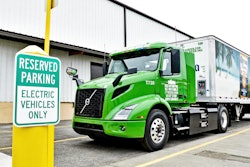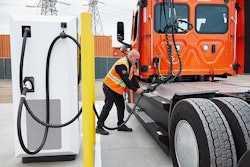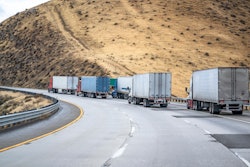Hours of service (HOS) rules require long haul truckers to get creative in predicting where they will be and at what time the wheels must stop turning. Imagine having to forecast every day exactly where you will need to stop without fully knowing what your next trip is, or how long the wait may be to get through the gate at a particular distribution center to drop your trailer, or what traffic and weather will be.
Predictive software can only get you so far. At some point, you might need to stop short of the goal line knowing that the next possible stopping place is likely too far given your remaining legal drive time. I equate this with planning a trip to the grocery store with just enough gas in the car to get there and back, but then encountering traffic, road construction, animals crossing the roadway, etc., and then having to divert to a gas station to solve my range anxiety, knowing that the extra out-of-route miles and time mean I will miss an appointment with a contractor showing up at my home to repair something.
That’s just an example, but it highlights the fact that life for truck drivers is a lot more complicated than getting from here to there. There are plans, and then constant readjustment of the plans, as the real-world interferes with those plans. The goal is to get the freight to its destination when it’s supposed to be there without violating any rules or endangering anyone.
When you see a truck randomly parked on the side of an exit ramp, it’s most likely not the result of a breakdown, but rather compliance with HOS rules. Would you feel comfortable randomly parking overnight on a remote exit ramp or in a high crime area? As consumers of freight, we are invariably asking drivers to do that because we expect our overnight shipment to be on our doorstep in the morning.
Drivers are often penalized for late deliveries, irrespective of what caused the delays. They often are not paid for wait time at facilities, when their wheels are not rolling because the distribution center is backed up with traffic or slow to load a trailer.
Think about how frustrated you might be when you go to a health care facility for a scheduled appointment, only to have to wait a few hours because the doctor got tied up with someone else’s emergency. Or when you arrive at the airport only to find weather in another time zone has delayed your flight for hours. Truck drivers deal with these challenges every day.
When you are paid by the mile and the truck isn’t moving, that is lost income. When you have to park 100 miles before a scheduled delivery because HOS would expire in those last few miles – and you wind up getting penalized the next day for a late delivery – that is lost income. When a distribution center ties you up in detention for an hour or two because they are slow, that is lost income.
Wouldn’t it be great if the service repairperson who promised to be at your home at 9 a.m. Tuesday had to reduce his fees for every minute they were late?
Drivers end up having to eat costs associated with real-world delays. The thing is, the delays will not get better unless they are measured. Often the distribution centers don’t track the delays they cause. Fleets don’t really have a way of assigning delays to traffic or weather or HOS challenges. They all likely measure missed deliveries, though.
In this data-rich world we live in, it seems like a fairly simple thing to start measuring the delays others cause that drivers have to deal with. The fact that many companies have no financial incentive to do so is a roadblock to making drivers more efficient. Fleets are likely unwilling to penalize shippers for delays that impact drivers; sort of biting the hand that feeds them.
In a tight shipping market, where finding trucks is at a premium, fleets can just choose to not take business from shippers with poor detention times, but during other times, fleets are competing desperately for customers and can’t afford to turn down jobs.
Making the freight system more reliable and more efficient represents adding capacity for shippers, which should tend to reduce costs for the shippers, as more capacity means more pricing competition. Better system efficiency also means lower net emissions as vehicles are idling less waiting in lines at facilities.
I’m going to introduce a new term: Total Shipping Time (TST). TST would be a metric that analyzes freight at a system level and would include the fleet, the shipper, and all the network of contributors to the time it takes to move a product from point A to B.
That metric would measure things such as detention time, traffic delays, weather delays, complexities with HOS compliance, and more. Measuring those categories on a per load basis would establish the groundwork for improvement.
Geospatial load tracking has gotten pretty sophisticated with knowing where the freight is in transit. Apportioning that transit to the multiple segments is not well tracked. This is as simple as looking at the geospatial data for a load and categorizing it into where and when based on speed. For example, where was the load at 0 mph for more than 5 minutes at a time? Where and when was it between 10 and 20 mph? Where and when was it above 55 mph?
That level of detail is needed to begin to understand a driver’s day and it’s required to help start the discussion on how to make the driver more efficient.
I’m not recommending adding any data tracking burdens on the drivers. The data is already out there being automatically collected. It’s just not being mined in any sort of standardized way and not being provided to all the participants involved in moving freight.
Making shipping more efficient benefits everyone. Improving the shipping process starts with identifying everyone’s role. Getting a package efficiently from A to B is not just the responsibility of the driver.













